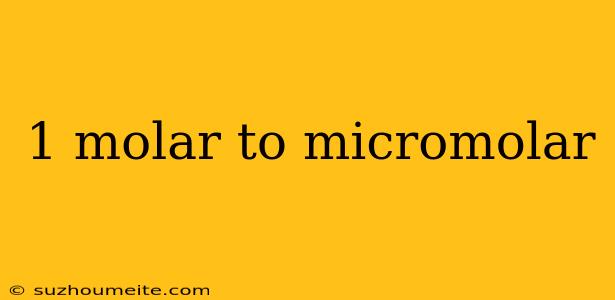Molar to Micromolar: Understanding the Conversion
In chemistry, concentrations of solutions are often expressed in units of molarity, which is the number of moles of solute per liter of solution. However, in some cases, it is more convenient to express concentrations in units of micromolarity, which is the number of micromoles of solute per liter of solution. In this article, we will explore the conversion from molar to micromolar and provide examples to illustrate the process.
What is Molarity?
Molarity is a unit of measurement that expresses the concentration of a solution in terms of the number of moles of solute per liter of solution. It is denoted by the symbol "M" and is calculated using the following formula:
Molarity (M) = Number of moles of solute / Volume of solution in liters
For example, if you have 1 mole of sugar dissolved in 1 liter of water, the molarity of the solution would be 1 M.
What is Micromolarity?
Micromolarity is a unit of measurement that expresses the concentration of a solution in terms of the number of micromoles of solute per liter of solution. It is denoted by the symbol "μM" and is calculated using the following formula:
Micromolarity (μM) = Number of micromoles of solute / Volume of solution in liters
Since 1 mole is equal to 1,000,000 micromoles, we can convert molarity to micromolarity by multiplying the molarity value by 1,000,000.
Converting Molar to Micromolar
To convert molar to micromolar, you can use the following conversion factor:
1 M = 1,000,000 μM
For example, if you have a solution with a molarity of 0.5 M, you can convert it to micromolar as follows:
Micromolarity (μM) = 0.5 M x 1,000,000 = 500,000 μM
Alternatively, you can use an online conversion calculator or a scientific calculator to perform the conversion.
Examples and Applications
Converting molar to micromolar is commonly used in various fields such as biochemistry, pharmacology, and biology. Here are a few examples:
- In biochemistry, the concentration of enzymes in a solution is often expressed in micromolar units.
- In pharmacology, the concentration of drugs in a solution is often expressed in micromolar units.
- In biology, the concentration of biomolecules such as DNA and proteins in a solution is often expressed in micromolar units.
In conclusion, converting molar to micromolar is a simple process that involves multiplying the molarity value by 1,000,000. Understanding this conversion is essential in various fields of science and is often used to express the concentration of solutions in a more convenient unit.
